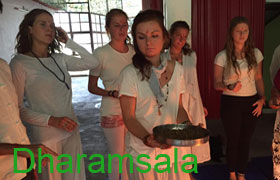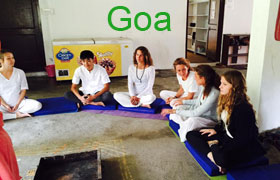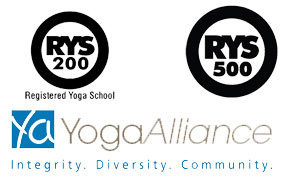Bhastrika Pranayama
Bhastrika pramayama is described in variety of forms in each resource. According to kaivalyadham there are 4 types of Bhastrika. In other words, Bhastrika is divided into four parts.
Prathama Bhastrika:
Kapalbhati + suryabhedan = pratham bhastrika
Prathama Bhastrika is started with kapalbhati which is practiced for 20 times. After that, you should practice poorak with your right nostril and rechak with your left nostril similar to suryabhedan. This should be repeated for 3 cycles.
Dvitiya Bhastrika:
Kapalbhati + Ujjayi = dvitiya bhastrika
Here also you should start with kapalbhati and practice it for 20 times followed by ujjayi. Thus you should inhale air through both the nostrils making a sound in your throat and exhale it through left nostril using rechak. This should be repeated for 3 cycles.
Trutiya Bhastrika:
Close your right nostril and practice kapalbhati with your left nostril alone for 20 times. After that you should inhale through your left nostril and exhale through right nostril. Now practice kapalabhati with right nostril for 20 times and poorak with right nostril followed by rechak with left nostril. This constitutes one cycle. This can be practiced for 3 cycles.
Chaturthi Bhastrika:
Close your right nostril with your thumb and observe poorak with your left nostril. Then close your left nostril with your index finger and observe rechak. Now practice poorak with left nostril and rechak with right nostril. So repeat this process alternately such that you practice poorak with right nostril and rechak with left nostril for 20 times and poorak with left nostril and rechak with right nostril for 20 times again. This will constitute one cycle. You should practice 3 cycles of this.
Benefits
Bhastrika ia capable of reducing the carbon dioxide content in your lungs. It is highly effective on asthma and other diseases related to lungs. It can relieve you from swollen throat and dry cough. It balances the nervous system and strengthens it. It brings in mental peace and concentration and prepares the seeker for meditation.
Regular practice of this makes the mind, body and soul motivated. The seeker’s personality becomes highly sensitive and hence becomes receptive of high, divine and subtle waves. Its regular practice makes you healthy and relieved from all the diseases. The yoga teacher training in Dharmasala can train you with bhastrika pranayama through the excellent assistance of our faculty.
Bhramari Pranayama
This pranayama involves making sound like a black beetel. Bhramar means black beetel. Hence it is called Bhramari pranayama. Close both of your ears with the thumbs of both of your hands. Place both of your index fingers on your forehead, middle fingers on eyes and ring finger on your nostrils and your little fingers on your mouth. Now practice poorak with both of your nostrils and chant om while your practice rechak. But you should chant om with your mouth shut and the sound should emerge from your throat alone. This can be repeated for 10 to 20 times.
Benefits
It improves mental tranquility and memory. It relieves you from all kinds of mental disorders. In the initial stages of the practice, you will hear the sound of a beetel, which will be transformed into the music of a flute at later stages with continuous practice. You may listen various other sounds too ranging from the thunder storm to the sound of a beetel as you progress through your practice. Hence hearing these sounds indicates the progress of your practice in turn. When the seeker hears these sounds he should meditate over a jyoti that resembles that sound. Once his mind gets dissolved into this jyoti he will experience the eternal bliss.
Moorcha Pranayama
Sit in any meditative posture and practice poorak. Simultaneously raise your head to an angle of 45 degrees. Set your vision to sambhavi mudra. Press your hands against your knees, keep your elbows straight and practice kumbhak as long as possible along with sambhavi drushti. When you feel you can no longer practice kumbhak you should gradually exhale air and bring your head down and eyes to normal state and close them. Breath normally and feel your mind spreading light and peace all over. Now try to visualize what you feel. This moorcha pranayama should be practiced for 3 to 10 cycles of repetitions.
Precautions
People suffering with high blood pressure, giddiness or any injury to the brain should not practice this paranayama.
Benefits
Practice of morrcha pranayama prior to meditation is very useful. It is a very powerful practice. One who succeeds in this practice will be able to experience the eternal bliss. The mind of such person will become introverted automatically which is extroverted by nature.
Plavini Pranayama
Plavini pranayama involves drinking air just the way we drink water. When the stomach is full, you should expel out all the impure air.
Benefits
It is the best pranayama for all stomach related issues. It is not practiced early in the morning initially as it is dangerous at that stage. But once the seeker masters this pranayama he will be able to float in the water even without swimming.
Once the air enters the sushumna the siddhi of kumbhak itself is considred the most significant accomplishment in parana sadhana. In this sadhana, the iar enters agnyakari chakra after progressive siddhi of panchbhut dharana namely pruthvidharana, jaldharana, aagneyadharana, vayavidharana and aakashdharana. At this stage the seeker will accomplish his target of dhyana. He will be able to realize kaivalya after which there is nothing to be achieved. On the other hand, every chakra of kundalini is awakened in order and reaches sahasrar chakra along with granthibhedan from the agnyachakra. This is considered the highest accomplishment in this order. This opens the door to salvation. Therefore kundalini siddhi is considered the key to the door of salvation.
1. The breath of the seeker of pranayama gets regulated. Thus he is relieved from all the diseases and his longevity is increased. Our longevity directly depends on our breath. Thus our longevity depends on how long breath we can take in. One who breathes at a faster rate will have to perish soon. Thus we are given a limited number of breathes for each life. How we use them is in our hands. In general we tend to breathe 12 to 15 times per minute. But if you run or if you are involved in any ill deed, your breathe count raise to 30 to 35 times per minute. Thus you waste away 15 breathes per minute when you are involved in misdeeds. Therefore your longevity reduces to half.
2. Thus every pranayama makes the mind introverted which is by nature extroverted. According to Shri Swati Ramji Maharaja –
चले वाते चलन चित्तं निश्चल भवेत् |
योगी स्थाणु त्वमापनोति ततो वायुं निरोधयेत् ||
3. Our mind wanders until our breath is not regulated. Once it is done it will be automatically controlled and gets on to the path of dharana, dhyana and Samadhi on its own. Thus breath is the only power and strength of life. It alone can lead you to the path of salvation. One who followed this path achieved things that are superior to this world and remained role models for our society.
The yoga teacher training in Goa is the best for learning any type of pranayama technique.




